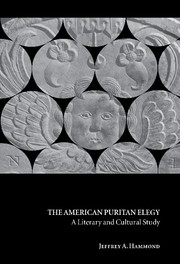Book contents
- Frontmatter
- Contents
- Preface
- Acknowledgments
- Introduction
- Chapter 1 Monuments enduring and otherwise
- Chapter 2 Toward an anthropology of Puritan reading
- Chapter 3 Weep for yourselves: the Puritan theology of mourning
- Chapter 4 This potent fence: the holy sin of grief
- Chapter 5 Lord, is it I?: Christic saints and apostolic mourners
- Chapter 6 Diffusing all by pattern: the reading of saintly lives
- Epilogue: Aestheticizing loss
- Notes
- Works cited
- Index
Chapter 3 - Weep for yourselves: the Puritan theology of mourning
Published online by Cambridge University Press: 22 September 2009
- Frontmatter
- Contents
- Preface
- Acknowledgments
- Introduction
- Chapter 1 Monuments enduring and otherwise
- Chapter 2 Toward an anthropology of Puritan reading
- Chapter 3 Weep for yourselves: the Puritan theology of mourning
- Chapter 4 This potent fence: the holy sin of grief
- Chapter 5 Lord, is it I?: Christic saints and apostolic mourners
- Chapter 6 Diffusing all by pattern: the reading of saintly lives
- Epilogue: Aestheticizing loss
- Notes
- Works cited
- Index
Summary
What, for early New Englanders, did it mean to die? And what did death's uncertainties mean for those charged with the sad task of commemorating loss? For these as for most questions, Puritans sought answers in God's Word, developing views that they considered to be fully biblical even though the Bible gave mixed messages regarding death's significance and proper observance. Although these varied messages in part reflected broader contrasts between the two Testaments, Puritans harmonized the differences in a manner consistent with their approach to biblical typology. From the Hebrew Bible they borrowed the how of mourning, including many of its forms and conventions. From the New Testament they derived the why of mourning, the spiritual goals that would justify the use of those forms and conventions. In order to understand the construction of death and commemoration fostered by New England's elegists, we must first consider what they found when they turned to the Scriptures for guidance.
Like all ancient peoples, the authors of the Hebrew Bible pondered the mysteries of death. Unlike many, however, they refused to romanticize it, generally seeing it as a malevolent force nearly equivalent to faithlessness. Life and death were linked in the Law with “blessing and cursing: therefore choose life, that both thou and thy seed may live” (Deut. 30:19).
- Type
- Chapter
- Information
- The American Puritan ElegyA Literary and Cultural Study, pp. 69 - 100Publisher: Cambridge University PressPrint publication year: 2000

